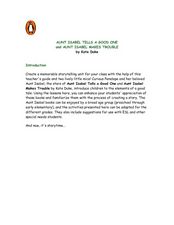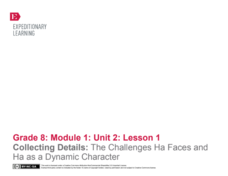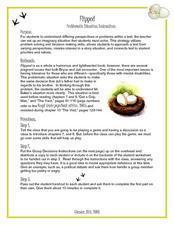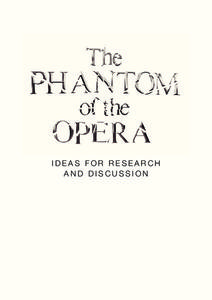Curated OER
Lesson Plan 4: Creating Main Characters
Creating a good main character is a must when writing a creative narrative or novel. Elementary aged writers create main characters for the novel they are writing. They first use themselves as a models, then create a character as a...
Bright Hub Education
"The Kid in the Red Jacket": Book Activities
Learning stations aren't just for little ones; middle schoolers can have fun while learning about the main character in the book, The Kid in the Red Jacket. Outlined are three different activities that are completed as each small group...
EngageNY
Contrasting Two Settings (Chapter 6: "Lost Melones/Cantalouples")
Continue working through Esperanza Rising, by Pam Munoz Ryan, by looking into language choices and discussing text-dependent questions. Pupils converse in small groups and as a class about plot, setting, and figurative language. Using...
Curated OER
Lesson Plan 10: Writing Really Good Dialogue
Boring dialogue can run a great story into the ground; get your novelists using dialogue as a tool to move their story into deeper and more developed territory. As part of a larger writing series, this lesson has a worksheet that can...
Curated OER
Aunt Isabel Tells a Good One...
Explore language arts by reading two similar stories in order to compare and contrast them in class. Young readers read two Aunt Isabel books, by Kate Duke, and discuss the main characters, plot, and setting. They complete a graphic...
Curated OER
Because of Winn-Dixie
Readers analyze an excerpt from Kate DiCamillo's novel Because of Winn-Dixie. They read silently, and then hear it read aloud. Definitions for underlined vocabulary words are in the margin, and other potentially difficult words are in...
Novelinks
Count of Monte Cristo: Questioning Strategy – Tossed Terms
Do you know the setting of The Count of Monte Cristo? What about the main characters? Explore the elements of Alexandre Dumas' novel with a reading comprehension activity. Kids toss boxes with literary elements written on each side, and...
EngageNY
Gathering Evidence and Drafting a Two-Voice Poem (Chapter 13: "Los Duraznos/Peaches")
Begin class with a short comprehension quiz and review and then move into a new genre: two-voice poems. The activity provides information about this type of poetry as well as a video example made by eighth graders that you can show your...
EngageNY
Analyzing Character: Who is Lyddie?
Character analysis can help readers feel more connected to a literary text. Scholars explore the topic by writing an acrostic poem about the main character from Katherine Paterson's novel, Lyddie. Then, pupils watch a short video to help...
Hawaiʻi State Department of Education
Finding the Main Idea
You can mix almost any subject with an arts curriculum. Find out how to use drama to find the main idea of a literary text. You'll read a story, and then learners will make tableaus showing what happened, or what they think will happen...
EngageNY
Collecting Details: The Challenges Ha Faces and Ha as a Dynamic Character
What is a dynamic character? Using an interesting resource, scholars set out to answer the question. They create graphic organizers to collect details about character development as they read the novel Inside Out & Back Again. They...
Teacher's Corner
Compare and Contrast Dr. Seuss
Celebrate Read Across America Day and Dr. Seuss' birthday with this compare and contrast graphic organizer in which three stories are examined for their setting, characters, problems, events, and solution.
Curated OER
Comprehension: Identify Story Grammar
This fully scripted lesson could be a big help for someone new to teaching Kindergarten. It outlines what you should do and say as you teach grammar and literary elements such as, main character, setting, and events through reading. The...
Curated OER
Visualization: Cricket in Times Square
After reading The Cricket in Times Square chapter titled "Caught in the Kitchen," learners list three describing details about the characters and setting. Groups collaborate to find sensory details to support their character assertions....
Hawaiʻi State Department of Education
Reporting on History
Have fun with history and turn your kids into news reporters of the past. Each group will research, script, and deliver a news report on a historic event they are studying in class. They'll identify the main characters of the historical...
Brigham Young University
Flipped: Problematic Situations
An activity based on the young adult novel Flipped, groups work to make the same difficult decision a character in the novel faces. Each group is given the same scenario about caring for a mentally disabled brother personally or putting...
Maryland Department of Education
The Concept of Identity Lesson 7: Logical Fallacies
What are the effects of competition in an academic environment? The competition between the main characters in A Separate Peace motivates a series of activities that asks readers to take a stance on competition, and then to develop a...
Generation Rx
My Generation Rx: Plot Twists
How can prescription drugs be dangerous if they were prescribed by a doctor? Is it okay to share your prescription drugs with friends if they really need them? Clear up any common misconceptions about prescription drugs with a set of...
Curated OER
Interpreting Dramatic Works
Action! Delve into character development in the play Fences by August Wilson, setting the stage for learners to analyze character nuances. Thespians choose a scene from the script, responding with a written account of the character's...
Curated OER
Story Map for Bud, Not Buddy
Why should your class complete a story map? After reading Bud, Not Buddy, divide your class into pairs or small groups to complete the included worksheet. They list the main characters, the conflict, main plot events, the resolution, and...
Syracuse City School District
Literary Elements
Address the literary elements in a piece of writing using these materials. The packet includes plenty of resources, and focuses mainly on theme, character, and point of view, with some materials for setting, symbolism, and author's...
Phantom of Opera
The Phantom of the Opera: Ideas for Research and Discussion
You could spend a full day discussing The Phantom of the Opera and not scratch the surface, but a set of lessons about the literary elements and themes of the musical production is a great start. Young thespians build upon the background...
Curriculum Corner
Guest Teacher Plans Grade 5
Math, reading, writing, and word work; it's all here in a daily lesson plan created to support a substitute teacher in a fifth grade class.
Maine Content Literacy Project
Introduction to Ernest Hemingway
What is a white elephant, and what does it have to do with Ernest Hemingway? Study "Hills Like White Elephants" in-depth by following the procedures outlined in this instructional activity, the fifth in a series of fourteen. Learners...

























